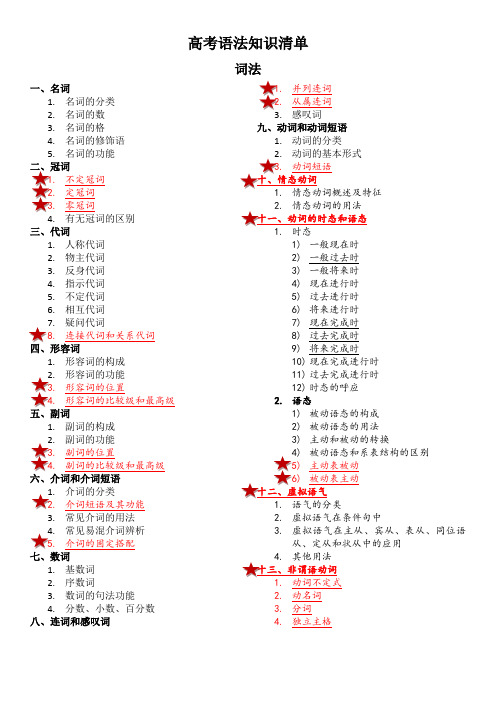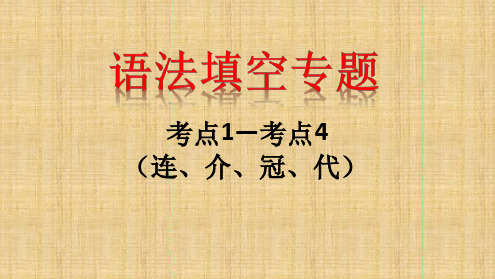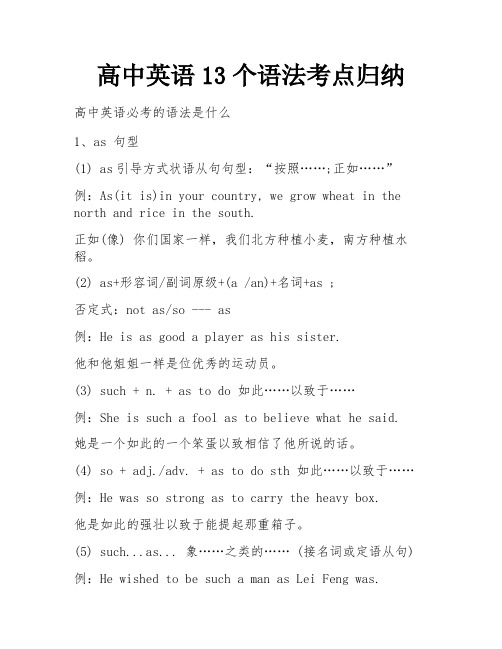高考英语语法总结(图片精华版)
(完整word版)高考英语语法知识清单

高考语法知识清单词法一、名词1. 名词的分类2. 名词的数3. 名词的格4. 名词的修饰语5. 名词的功能不定冠词定冠词零冠词有无冠词的区别三、代词1. 人称代词2.物主代词 3.反身代词 4. 指示代词5. 不定代词6.相互代词疑问代词连接代词和关系代词1. 形容词的构成 形容词的功能 形容词的位置形容词的比较级和最高级1. 副词的构成 副词的功能 副词的位置副词的比较级和最高级 六、介词和介词短语介词的分类介词短语及其功能 3. 常见介词的用法 常见易混介词辨析 介词的固定搭配 七、数词1. 基数词2. 序数词3. 数词的句法功能4. 分数、小数、百分数 八、连词和感叹词 并列连词从属连词 感叹词九、动词和动词短语1. 动词的分类2. 情态动词的用法 1) 一般现在时 2) 一般过去时 3) 一般将来时 4) 现在进行时 5) 过去进行时 6) 将来进行时 7) 现在完成时 8) 过去完成时 9) 将来完成时10) 现在完成进行时 11) 过去完成进行时 12) 时态的呼应 2. 语态1) 被动语态的构成 2) 被动语态的用法 3) 主动和被动的转换2. 虚拟语气在条件句中3. 虚拟语气在主从、宾从、表从、同位语从、定从和状从中的应用 4. 其他用法 动词不定式 2. 动名词 3. 分词 4. 独立主格句法一、句子成分和句子种类1.句子成分2.句子种类2.主谓一致的几种情况2.主语从句3.宾语从句4.表语从句5.同位语从句6.直接引语和间接引语2.定语从句的分类3.关系代词4.关系副词5.介词+关系代词6.注意事项7.定语从句和同位语从句的区别8.定语从句和短语的转化2.地点状语从句3.条件状语从句4.目的状语从句5.原因状语从句6.结果状语从句7.让步状语从句8.比较状语从句9.方式状语从句10.状语从句的省略六、特殊句式1.there be结构倒装强调省略5.插入语七、情景交际1.社会交往2.态度3.情感。
高中英语语法大全全课件非常详细(561张PPT)PPT课件

Two teas, please. 请来两杯茶。
d. 抽象名词有时也可数。
four freedoms 四大自由
the four modernizations 四个现代化
many interests 许多兴趣
精选PPT课件
15
精选PPT课件
16
问题1
The ______ is just around the corner and you won’t miss it. (01北京春季)
有些抽象名词和物质名词也可转化为可数名词,用
来表示某种特定的意义。a knowledge of …表示
“对……有所了解“。又如:
This meeting is a great success.
请看下面的可数与不可数名词的转化:Βιβλιοθήκη 精选PPT课件14
a. 当物质名词转化为个体名词时。
Cake is a kind of food. 蛋糕是一种食物。 (U)
A. a four hour C. a four-hours
B. a four hour's
✓D. a four hours'
精选PPT课件
18
问题3: There are only twelve _____ in the hospital.
✓ A.woman doctors B.women doctors
大多数不可数名词都不可能转化为可数名词,常
见的有:information; news; advice; progress;
fun ……如:
This is not a match. We’re playing chess for _____.
✓ A habit B hobby C fun D game (2001上海春季)
高考英语:全部知识体系结构图及50个必考知识点!

高考英语:全部知识体系结构图及50个必考知识点!2019年1月27日一、简单句的五个基本句型1.主语+不及物动词2.主语+及物动词+宾语3.主语+系动词+主语补语4.主语+双宾动词+间接宾语+直接宾语5.主语+宾补动词+宾语+宾语补语二、复合句:宾语从句,状语从句,定语从句定语从句:n、pron+先行词+句子(不完整的) 宾语从句:主+谓(vt)+宾状语从句:主+谓+宾语+状语三、被动语态:对应的被动语态也有八种:1.一般现在时isamare+P.P(过去分词)2.一般过去时waswere+P.P3.一般将来时will be+P.P4.现在进行时isamare+being(固定不变)+P.P5.过去进行时waswere+being(固定不变)+P.P6.现在完成时havehas been+P.P7.过去完成时had been+P.P8.过去将来时would have been+P.P四、动词的时态:1、一般现在时的用法:1)表示现在的习惯,经常发生的动作或存在的状态。
2)表示主语的特征、性格和能力。
3)表示客观事实或真理。
4)表示按照计划安排好的将来行为。
(只限于是go,come,leave,start,stop,be等开始或移动意义的词。
)2、一般过去时的用法:1)表示过去的动作或状态。
2)叙述过去连续发生的事情。
3)表示过去一段时间内经常发生的动作。
3、一般将来时的用法:1)表示将来的动作或状态。
2)表示将来的经常动作。
4、现在进行时的用法:1)表示说话时正在进行的动作。
2)表示现阶段正在进行的动作。
(说话时动作不一定进行。
)5、过去进行时的用法:1)过去某一时刻或某一段时间内正在进行的动作。
2)表示移动的动词:come,start,stay,leave,go等词的过去进行时可以表示过去的将来要发生的动作。
3)wasgoingtodo可以表示在过去某一时间之后发生的动作。
6、现在完成时的用法:1)表示刚刚完成的动作,常与just连用。
高中英语2025届高考语法复习句法知识讲解(主谓一致+动词时态+助动词)

高考英语语法复习句法知识讲解一、主谓一致在英文中,谓语的形式要与主语保持一致。
比如,你、我、他是学生,中文“是”字是一样的,只有主语不同。
英文的动词要根据主语不同而改变:I am,you are,he is。
主谓一致有三大原则:语法一致,意义一致,就近一致。
(一)语法一致名词是单数,谓语动词是单数。
不可数名词、集体名词、动词不定式、动名词等,谓语动词也用单数。
Knowledge is power. 知识就是力量。
The team is playing well. 这个团队表现得很好。
To see is to believe. 眼见为实。
Swimming is good exercise. 游泳是一项很好的运动。
记住:绝大多数都用单数,只有明确的复数名词,谓语动词才用复数。
My parents are teachers. 我的父母都是老师。
The shoes are all right. 这些鞋子很合适。
鞋、裤子、眼镜,只能是复数,如果前面加上“一双”“一条”,后面的动词就是单数。
A pair of glasses is very expensive. 一副眼镜很贵。
要想搞清楚谓语用单数还是复数,一定要准确锁定主语。
All except me in my family are going to the park. 很显然,all才是真正的主语,所以是复数。
She as well as the other girls is reading a book. 在这里,She才是真正的主语,所以是单数。
"more than one +名词"作主语时,谓语动词常用单数。
例如:More than one teacher gets the flowers."half of, the rest of, most of, all of, 百分数/分数+of +名词"作主语时,谓语动词形式根据of后的名词而定。
高考英语常用语法图解

高考英语常用语法图解一、名词I. 名词的种类:II. 名词的数:1. 规则名词的复数形式:名词的复数形式,一般在单数形式后面加-s或-es。
现将构成方法与读音规则列表如下:2. 不规则名词复数:英语里有些名词的复数形式是不规则的,现归纳如下:III. 名词的所有格:名词在句中表示所有关系的语法形式叫做名词所有格。
所有格分两种:一是名词词尾加’s构成,二是由介词of加名词构成。
前者多表示有生命的东西,后者多表示无生命的东西。
1. ’s所有格的构成:2. ’s所有格的用法:3. of所有格的用法:用于无生命的东西:the legs of the chair, the cover of the book用于有生命的东西,尤其是有较长定语时:the classrooms of the first-year students用于名词化的词:the struggle of the oppressed二、冠词:冠词分为不定冠词(a, an),定冠词(the),和零冠词。
I. 不定冠词的用法:II. 定冠词的用法:III. 零冠词的用法:三、代词:1. one, some与any:1) one可以泛指任何人,也可特指,复数为ones。
some多用于肯定句,any多用于疑问句和否定句。
One should learn to think of others. / Have you any bookmarks? N o, I don’t have any bookmarks.I have some questions to ask.2) some可用于疑问句中,表示盼望得到肯定的答复,或者表示建议,请求等。
W ould you like some bananas? Could you give me some money?3) some 和any修饰可数名词单数时,some表示某个,any表示任何一个。
I have read this article in some magazine. Please correct the mistakes, if any.4) some和数词连用表示“大约”,any可与比较级连用表示程度。
2020年高考英语语法填空考点(连、介、冠、代)(共20张PPT).ppt

as far south as James Bay in Canada.同从,that不指代evidence
2. (2019年全国Ⅱ卷·67) I work not because I have to, __b_u_t__
考点1—考点4 (连、介、冠、代)
语法填空主要考查考生在阅读理解的基础上运 用语法的能力。共 10小题,每小题 1.5分。在一篇
200词左右的短文中留出 10个空白,部分空白的后面
给出单词的基本形式,要求考生根据上下文 在空白 处填写1个适当的单词或所给单词的正确形式。
填1个适当的单词 所给单词的正确形式
8. _____ our excitement, our parade performance was a great success.
9. Brazil was named to host this important sporting event ____ October, 2009.
10. I didn't understand why this would happen and my credit card had already been charged _____ the reservation.
名词前,通常填冠词,根据语境及定冠词与不定冠词的基本用 法选用恰当的冠词。 (注:限定词主要是指冠词、形容词性物主 代词,以及some, any, another等不定代词)
1. (2019年全国Ⅰ卷·69) Of _t_h_e__ nineteen recognized polar bear
高考英语语法分类归纳、练习与分析(精华版)

高考英语语法分类归纳、练习与分析(精华版)一.Tenses and voicesA.现在完成时: 1)表示过去某时发生的行为对主语目前产生的影响。
即用过去发生的某个行为来说明现在的某种情况。
往往含有“已经……”, “已经……了”的意思。
Eg.Don’t think any more about it. I have decided not to help you.I have experienced that before, so I know how to deal with it.2) 到目前为止已发生的。
与so far, up till now, in the past/ last …….days/ years, today, this month/ year 等“包括现在在内的时间状语”连用。
My brother is an actor. He has appeared in several films so far.Great changes have taken place in this area in the recent years.3)表示过去开始的动作或状态延续到现在。
与for…/ since 连用。
He has worked in the south for ten years/ since ten years ago.Compare(1):完成进行时表示过去开始的动作一直在进行,直至现在。
He has been working on this project since last month.(2) 过去时态:指发生在过去某段时间内的事。
He once worked in the south for ten years (现在不在南方)(3) 过去完成时态:指发生在过去某个时间以前的动作或状态。
常与by/ by theend of..(到了……的时候”连用。
例如:1)By the time we got to the theatre, they had sold all the tickets.2)How many words had you leaned by the end of last year?Practice:1.It is reported that the pr esident once______ in the Viet Nam’s war for three years from 1966-1970. A. served B. had served C. has served D. was serving2. ---No one answered when I called at 6 yesterday.---I ________ to rock music and was absorbed in it.A listenedB was listening C. has listened D. had listened3.I wasn’t paying attention to what he was talking about, so I am afraid I ___ his speech very well.A. had not understoodB. has not understoodC. did not understandD. don’t understand4. I _____ goo d at table tennis, but I haven’t played it for ages.A. amB. wasC. has beenD. used to be5. I _________ where she gets her money all these days.A. am often wonderingB. often wonderedC. had often wondered D.have often wondered6. ---Tell me what _______ while I was absent.---A thief tried to break into the house when I _______ in your house.A. happened/ stayedB. was happening/ was stayingC. happened/ was stayingD. was happening/ stayed7. ---You are always watching TV.---Only on Sundays. And nobody ______ it but you.A. knowsB. has knownC. knewD. is knowing8. When the old man ______ to walk back to his house ,the sun _____ itself behindthe mountain.A.started ;had already hidden B.had started ;had already hiddenC.had started ;was hiding D.was starting; hid9. Years ago we didn't know this, but recent science ______ that people who don'tsleep well soon get ill. A. showed B. has shown C. will showD. is showing10. It ______ for weeks before the first cold wave struck the area.A. rainedB. was rainingC. has rainedD. had been rainingKeys:1)a 2)b. 3)c 4)a 5) 过去到现在d 6) c 7)a(经常性) 8)a 9) b 与现在有联系10)d二、Subjunctive Mood (虚拟语气)1.It is important that he __________ the college entrance examination.A. should attendB. will attendC. must attendD. had to attend8.Don’t come this morning. I would rather you________ the day after tomorrow.A. comeB. cameC.are to comeD. will come3._________ for the free tickets, I would not have gone to the film so often.A.If it is notB.Were it notC. had it not beenD. If they were not4.---Did you meet with the famous space hero YanLiwei?---________ I had come here earlier!A.But forB.If notC. For fearD. If only5.Without electricity human life __________ quite difficult today.A.isB.will beC. would have beenD.would be(分析:1.A虚拟语气的一种,句式It is necessary/strange/important that …should do2.B 3.C had it not been=if it not had been 4. D. If only= I wish 要是… 该多好啊5.D)三、非谓语:(to do/ doing / done)(By Yuan)1.To do(to be done)/ doing / done 作状语的区别:To do(to be done):作目的状语,结果状语(特定句型)Doing(being done, having done )/done:作伴随、时间、原因、让步、结果状语等。
高中英语13个语法考点归纳

高中英语13个语法考点归纳高中英语必考的语法是什么1、as 句型(1) as引导方式状语从句句型:“按照……;正如……”例:As(it is)in your country, we grow wheat in the north and rice in the south.正如(像) 你们国家一样,我们北方种植小麦,南方种植水稻。
(2) as+形容词/副词原级+(a /an)+名词+as ;否定式:not as/so --- as例:He is as good a player as his sister.他和他姐姐一样是位优秀的运动员。
(3) such + n. + as to do 如此……以致于……例:She is such a fool as to believe what he said.她是一个如此的一个笨蛋以致相信了他所说的话。
(4) so + adj./adv. + as to do sth 如此……以致于……例:He was so strong as to carry the heavy box.他是如此的强壮以致于能提起那重箱子。
(5) such...as... 象……之类的…… (接名词或定语从句)例:He wished to be such a man as Lei Feng was.他希望成为一个像雷锋这样的人。
(6) the same +名词+as 和……一样的…… (接名词或定语从句)例:He is not the same man as he used to be.他不是从前的那样子了。
(7) as 引导非限制性定语从句例:As is known to us, knowledge is power.众所周知,知识就是力量。
(8)引导时间状语从句,与while意义相近例:We get wiser as we get older.随着我们长大,我们也变得越来越聪明。
(9) 引导原因状语从句,与 because的用法相近例:As it was getting very late, we soon turned back.因为越来越迟了,所以我们不久就回来了。
